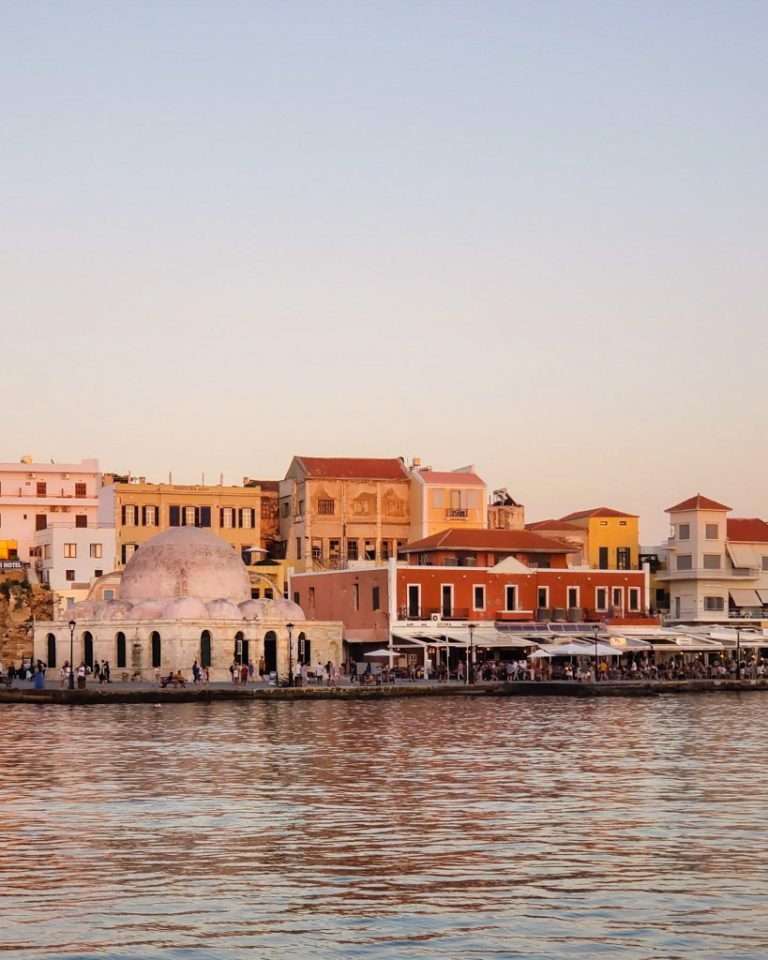This article may contain affiliate links. When you purchase something we recommend, we make a small commission. You don’t pay anything extra. 💘 For more details, check out our Terms of Use page.
If you are traveling to South Korea, you need to think about adding a cooking class experience to your itinerary.
Cooking classes is one of my favorite things to do when I travel, especially in places that less familiar.
You spend a few hours with a local, learn a bit of history, and walk away with a full stomach and recipes to try at home.
Overall, South Korea was one of the places were I splurged a lot on activities including a color analysis, the cooking classes, a perfume making class and more.
While searching, I noticed most sites had a lot of cooking class options. A lot of them were hosted in a house, which is not bad, but sometimes I want a more formal experience.
Here’s what I experienced and what I think you should book depending on your style and trip.
Table of Contents
Toggle1. Korean Cooking Club with Olivia (My Top Pick)
📍 Location: Jongno neighborhood — super central and easy to reach by subway
This was the first class I did, and it absolutely exceeded my expectations. The space is a professional kitchen studio with wide benches, plenty of tools, and a beautiful city view. Olivia, our instructor, was warm, funny, and clearly passionate about sharing Korean cuisine.
We cooked a full menu, including:
- Bulgogi (marinated beef)
- Japchae (glass noodles with veggies)
- Kimchi pancakes
- A variety of side dishes
- Rice, sauces, and more
There were only three of us in the group, so we had lots of time for questions, one-on-one support, and laughs throughout. The session ended with us sitting down to enjoy a feast we’d made — and still had leftovers for lunch the next day.
Bonus: We got a printed recipe booklet, a reusable tote bag (that I still use), and enough insight into Korean home cooking to feel way more confident about ingredients and methods.
Price: Around $108 per person
Duration: ~2.5 hours
You can check out availability here, and use the link to book your spot.
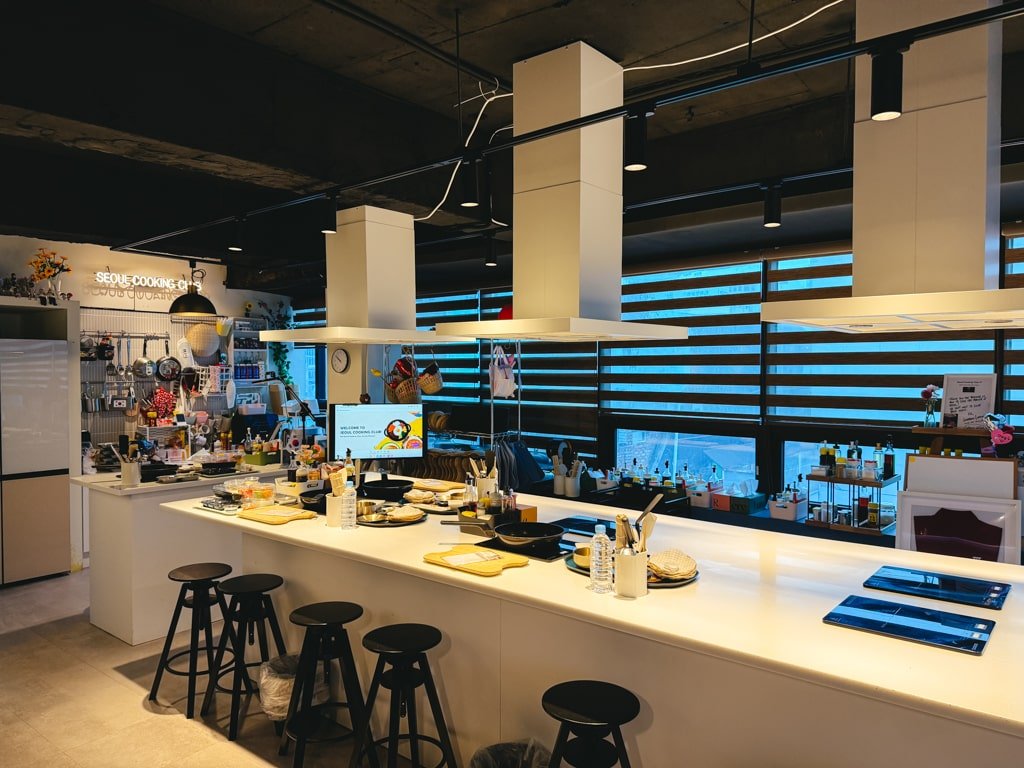
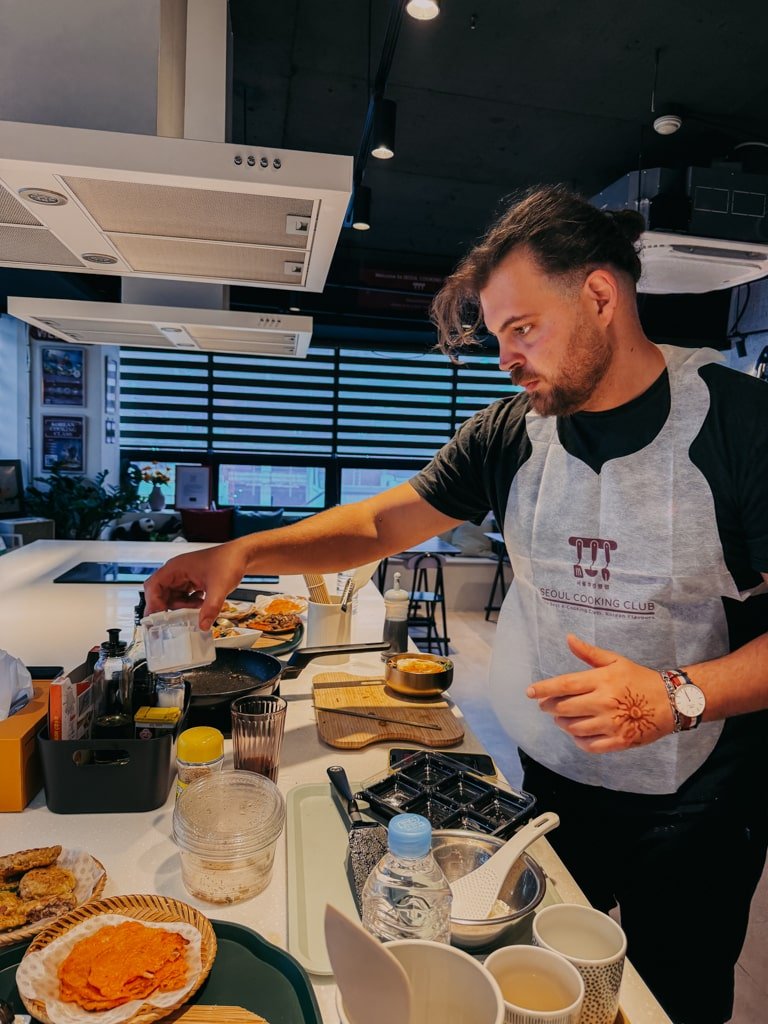

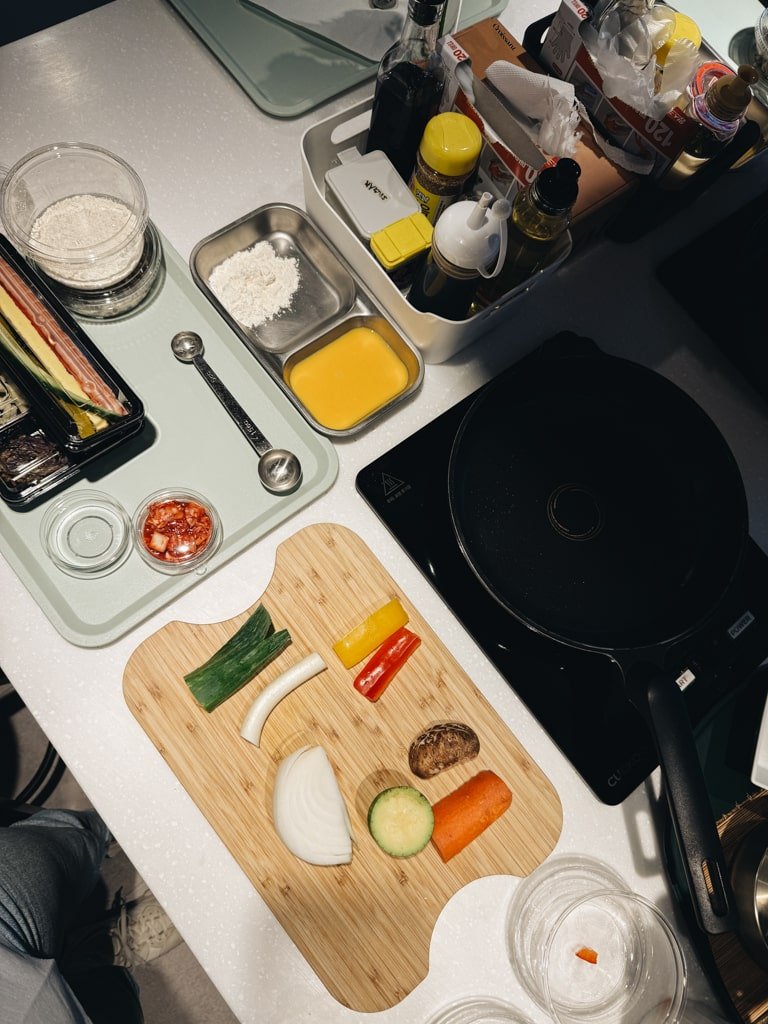
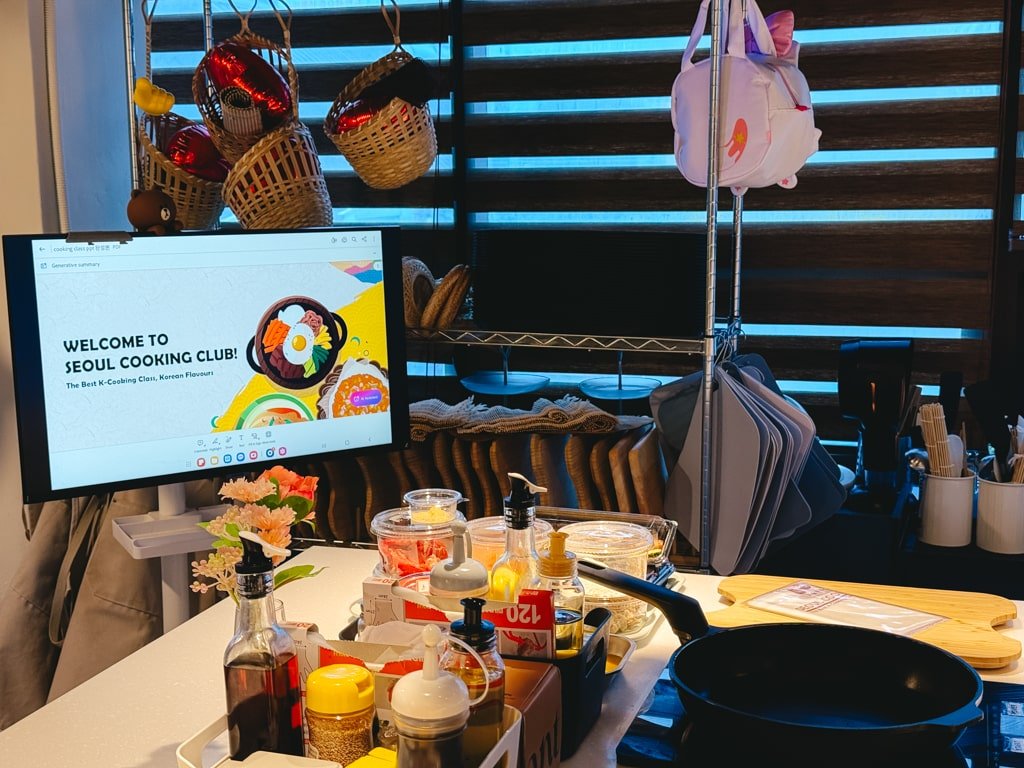
2. Handmade Noodles & Kimchi with Korean Grandma
📍 Location: Near Hongdae (combine it with a stroll through the area after)
This one had a totally different vibe — more casual, more traditional, and just as memorable. The highlight for me was the beginning: we were welcomed with crispy rice snacks that were weirdly addictive. You think you’ll have just one. You will not.
The class included:
- A step-by-step kimchi presentation (plus hands-on prep)
- Making fresh knife-cut noodles by hand
- Cooking everything together and sitting down for a shared meal
- A presentation on Korean culture
Unfortunately I didn’t take too many photos (I was too busy cooking to take many) but that’s honestly a good sign. The energy was homey and upbeat, and you really felt like you were being taught by someone’s cheerful aunt or grandmother.
The price is also very affordable so you can book this if you have a lower budget or less time. U
Why I recommend it: Cozy, authentic, and ideal for anyone interested in kimchi and old-school techniques
Price: Around $68 per person
Duration: ~2.5 hours
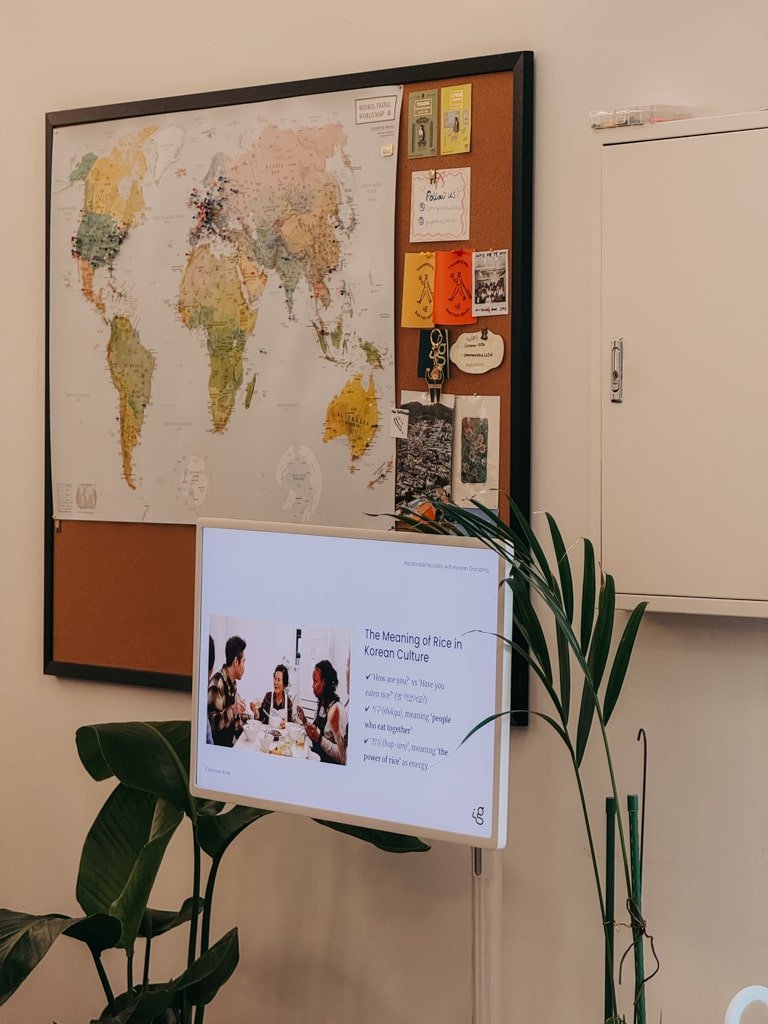
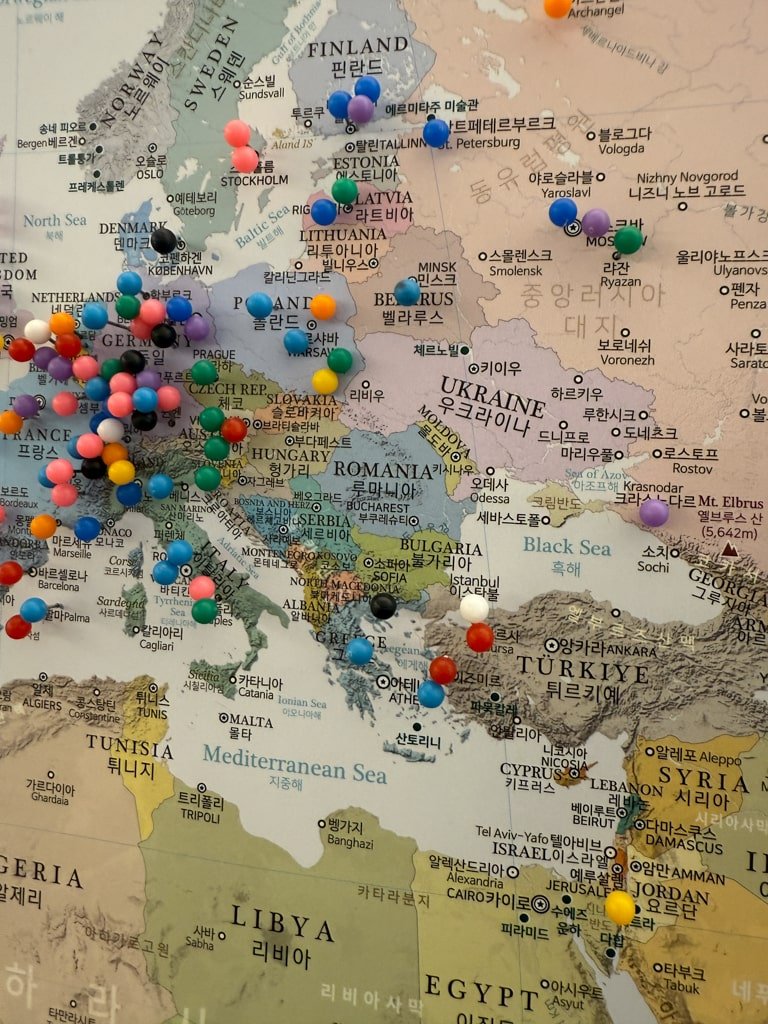
Why You Should Do a Cooking Class in Seoul
Unless you absolutely hate cooking, there’s no reason not to. Korean food can feel a bit intimidating from the outside, and has a lot of ingredients that I was unaware of, so doing a cooking class will get you to recognize flavors and cooking techniques faster. Plus, doing it right in the beginning trip helps with knowing what to order better.
If I had to choose one, I’d say:
→ Start your trip with the Cooking Club with Olivia — it’s generous, beginner-friendly, and immersive.
→ Then, add the noodle class if you want a second round with a totally different energy and a focus on kimchi.
You can book both through GetYourGuide and I highly recommend locking them in early if you’re visiting during high season.
ESSENTIAL INFORMATION
Must Know When Visiting South Korea
- Emergency: Dial 112 for police and 119 for fire or ambulance services. These lines are available 24/7 and usually offer English-speaking support.
- Language: English is spoken in most tourist areas and by younger Koreans, though it’s less common in rural towns. It’s helpful to learn a few basic phrases like “Annyeonghaseyo” for hello, “Kamsahamnida” for thank you, and “Joesonghamnida” for sorry. For live translation help, download Papago (by Naver).
- Navigation: Google Maps and Apple Maps do not work reliably for directions in Korea. Instead, download Naver Map or KakaoMap. Both offer accurate public transport, driving, and walking directions, and have English-language support built in.
- Water: Tap water is safe to drink across South Korea, though many locals still prefer bottled or filtered water. Most hotels and guesthouses will either provide bottled water or have a filtered dispenser available.
- Driving: Cars drive on the right-hand side in Korea, and an International Driving Permit (IDP) is required for tourists. Most traffic signs are in both Korean and English, but city driving can be fast-paced and stressful, especially in Seoul. Book your rental car with Discover Cars for the best rates and comparisons across all major and local companies.
- Accommodation: Booking.com is the most convenient option for finding hotels, hostels, guesthouses, and traditional hanok stays across Korea. Many listings include free cancellation, no prepayment, and access to a reliable rewards system for frequent travelers.
- Islands: South Korea has several beautiful islands to explore, including Jeju, Ulleungdo, and Geoje. Jeju is best reached by domestic flight, while others require ferries from mainland ports. You can use 12Go Asia or check directly with ferry operators to plan your route.
- Activities: There’s no shortage of things to do in Korea, from exploring palaces, to color analysis experiences and traditional markets to joining food tours, hiking, or even staying overnight at a Buddhist temple. For hassle-free bookings with verified reviews, use Get Your Guide to arrange activities in advance.
- Public Transport: Korea’s public transportation is fast, efficient, and easy to use. Major cities like Seoul and Busan have extensive subway networks, while intercity travel is best done using KTX high-speed trains or long-distance buses. As soon as you arrive, get a T-money card for easy access to subways, buses, and even taxis. You can also purchase a SIM card and T-money package online or at the airport to stay connected and ready to travel from the moment you land.
- Domestic Airlines: Korean Air and Asiana Airlines are the main full-service carriers, while Jeju Air, T’way, and Air Seoul offer low-cost domestic flights. Jeju Air is a popular and budget-friendly option, especially for trips to Jeju Island. If you’re collecting points, Korean Air’s SkyPass is the most established loyalty program.
- Taxi: Instead of flagging taxis on the street, use the Kakao T app to book one. It’s reliable, easy to use, shows price estimates, and allows you to pay in-app. While many taxis now accept cards, it’s still a good idea to carry a bit of cash just in case.
- Culture: Korean culture emphasizes respect, quietness, and social harmony. It’s customary to remove your shoes when entering homes or traditional accommodations. Public transport tends to be quiet, and loud talking is generally discouraged. Shops and restaurants usually stay open late and operate seven days a week, but keep in mind that museums, palaces, and some attractions are often closed on Mondays. Major holidays like Chuseok or Lunar New Year (Seollal) are times when many Koreans travel, and during those days, transportation and services may be limited.

